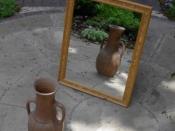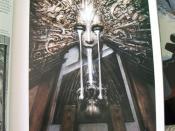Sylvia Plath's "Mirror" is a poem that deals with truths and lies and the progression of a woman towards old age. Oftentimes the "truth" of a person is not what is perceived by one's peers, resulting in the "lies" caused by opinion. The literary device of personification is utilized by the poet when she assigns human qualities to the mirror. The mirror itself is a premier symbol in that it is "not cruel, only truthful" (line 4). The mirror is the embodiment of truth, reflecting back at its gazer whatever it is presented with. The mirror is also the speaker of the poem, and because of that we receive not the feelings of the girl or woman, but the feelings of that person as perceived by the mirror.
The search for truth is introduced in the first stanza by several of the qualities of the mirror. "Whatever I see, I swallow immediately" (line 2) says that the mirror will take in and reflect whatever it is presented with, be it positive or negative.
The phrase, "unmisted by love or dislike" (line 3) makes the reader think of people who often change their feelings and tell lies about another person according to how much they like or dislike that person. The mirror does not and cannot do this. Truth is all it can reflect, no matter what that truth is. The mirror is "not cruel, only truthful" and can only judge by what it sees, not by its own opinion.
In the second stanza, we are presented with the woman's search for her true self. The mirror becomes a lake in this stanza. Unsatisfied with the image reflected by the mirror, the woman turns to another source of reflection, water. The phrase "Searching my reaches for what she really is"...


